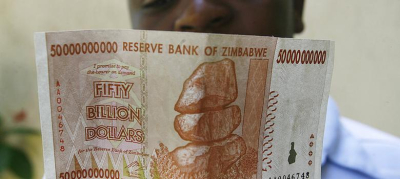When money becomes worthless ?

Money cannot buy happiness, goes the adage. If you were living in Zimbabwe in the early 2000s, there were a lot more things that money could not buy. In fact, the currency was so worthless at one point that using it to make crafts or as toilet paper was cheaper than using it to buy goods with it. This was the era of hyperinflation in Zimbabwe. Many countries have suffered from hyperinflation in the past, pushing their citizens to the brink of starvation. What caused the hyperinflation in Zimbabwe?
Excess money can be a bad thing!
Governments decide how much money they can print based on complex calculations. One of the important factors they consider during this process is the Gross Domestic Product (GDP). In simple terms. GDP means the monetary value of all finished goods and services within a country. When a country is producing more. Its GDP goes up and vice versa.
Zimbabwe was under the control of an authoritarian leader called Robert Mugabe between 1980 and 2017. In the early 2000s, the country was spending more than it was earning as revenue Mugabe's money managers came up with the not-so-brilliant idea of printing more currency to overcome the money shortage. This backfired.
How money works
The real wealth of a nation is not the money they print but the goods they produce and the services they offer- aka the GDP. Money is only an indicator of that wealth. So, when a country prints more money and distributes it to people, it drives up purchasing power-or the demand- while the amount of goods produced- or the supply-remains the same. Ergo, the cost of goods goes up, leading to massive price rise.
People in Zimbabwe, therefore, had a lot of money which could not buy them what they wanted. The government responded by injecting more money into the country. The consequence was so drastic that the prices were doubling every 24 hours. The rate of inflation reached an astronomical level- to 89.7 sextillion per cent per month! The government had still not leamt its lesson. It kept issuing higher denominator bank notes.
In July 2008, inflation hit its crescendo when the government issued a one hundred trillion dollar note (Zimbabwean Dollar). Its value. however, was just equal to 0.40 US dollars. In fact, the only time it fetched more was when it was sold as a novelty item on the internet. When inflation hit 230,000,000% in 2009, the country's reserve bank declared the U.S. dollar as its official currency.
Savings vaporised
Hyperinflation had devastating consequences for the people of Zimbabwe. Life became a daily struggle. as prices of essentials such food, medicine, and fuel became higher than the bills being printed. Within weeks and months, the cost of a loaf of bread went from hundreds of Zimbabwean dollars (2$) to millions At one point, it touched Z$550,000,000 in the regular market and Z$10 billion in the black market. With people being unable to afford consumption. businesses started failing. Unemployment soared. The money that people had saved in their bank accounts vaporised due to devaluation and in buying essentials.
The bubble bust
Unable to contain the inflation. Zimbabwe decided to abandon its own currency and began using foreign currencies for everyday transactions, including the US dollar, the South African rand, and the Indian rupee. This, along with government reforms. helped the country stabilise its economy to a large extent. The inflation came down to 0%, but it did not last long.
In 2019, the Central Bank of Zimbabwe abolished the multiple-currency system and replaced it with the new Zimbabwe dollar, restarting the old problem once again. Earlier this year, inflation spiked to 175% before coming down to 77% in August. Zimbabwe's real problems are not just with the currency, but with its low economic output, social indicators, and constant conflict in the region. The African nation's experience is a good example to understand why printing more money is not the answer.
Picture Credit : Google